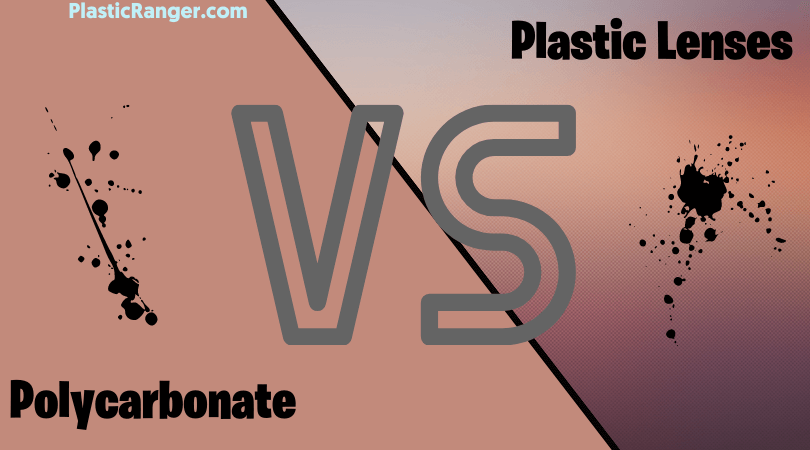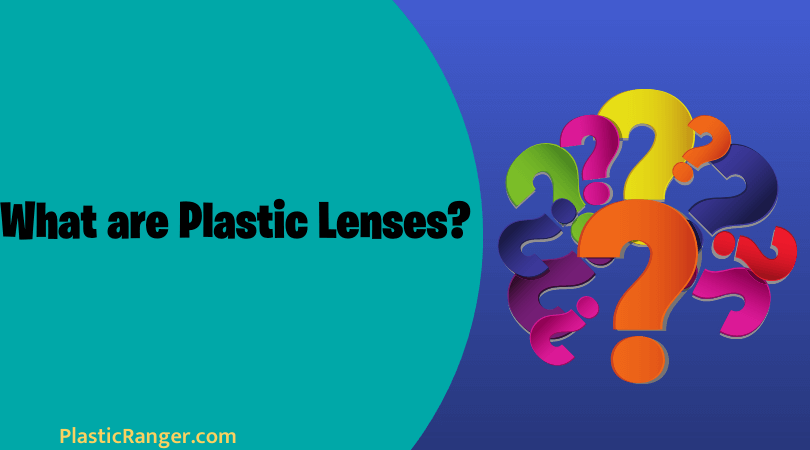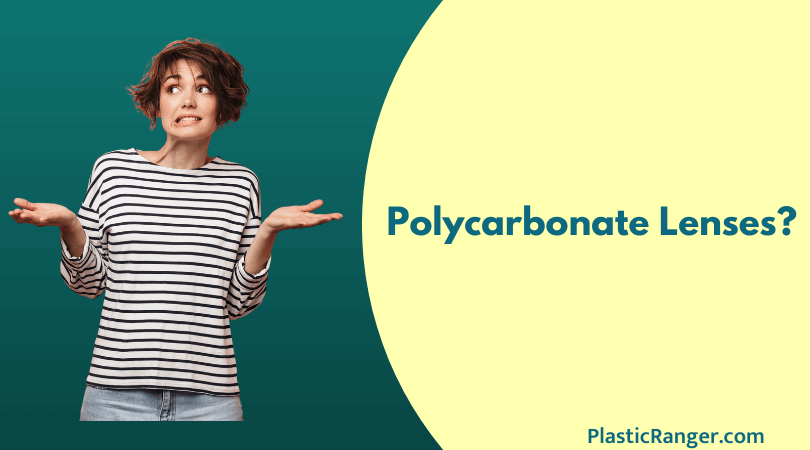Hello People. I hope you’re all doing well. Today I’m going to share a detailed piece on Polycarbonate vs plastic lenses. Keep reading to learn more.
Plastic VS Polycarbonate Lenses
Polycarbonate lenses have high impact resistance and are nearly shatterproof, making them ideal for people who keep dropping their glasses. On the other hand, plastic lenses are lighter, have great optical clarity, and are easy to tint.
Whenever you visit a market for a new pair of eyeglasses, you’ll be bombarded with many options, especially for lens material.
Sure, you’ll see many excellent eyeglasses on the market, and one of them will probably suit all your needs, but it is essential to look at both the pros and cons of a lens material to find the best pair of glasses.
Lens materials vary in flexibility, durability, weight, thickness, scratch resistance, etc. The most popular and preferred options for lens material are polycarbonate and other plastic lenses.
They do well in all three factors necessary for wearers – vision, comfort, and appearance.
What are Plastic Lenses? – An Overview
Plastic was introduced as an eyeglass material back in 1947, and since then, there has been no need for plastic as it has become a mainstream material for making eyeglasses.
However, the popularity of plastic lenses is diminishing. Still, there are a few situations where plastic lenses are always used.
Plastic lenses, also called CR-39, are preferred for many applications thanks to their high optical clarity, low cost, durability, and impact resistance. CR-39 is an acronym for “Columbia Resin 39,” the digit represents the 39th formula that made the resulting plastic material used in lenses.
Plastic lenses are a popular option for individuals with lower prescriptions due to their affordability.
They come in various colors and can be tinted for outdoor use or used as prescription sunglasses.
Interesting Read – Trivex VS Polycarbonate | The Definitive Guide
Advantages and Disadvantages of Plastic Lenses
Advantages
Low cost and affordability
Plastic lenses are affordable, making them easier to buy for a more significant section of the population.
The raw materials of plastic lenses are cheap and are readily available in desired amounts without creating loads of effort.
Even the manufacturing part of these lenses is inexpensive and easy, keeping the cost of the end product relatively down.
Lightweight
It is common knowledge that plastic materials are lighter than metals, solid, and durable to a certain extent.
Lightweight makes plastic materials the right fit for lenses because their low in weight, will not be heavy inside a glass frame, and are comfortable for the wearer.
Excellent Optical Clarity
The plastic used to make eye lenses is of high quality and goes through advanced refining procedures.
The transparency of plastic material is like a cherry on top of the cake as it provides optimum visual clarity and improved vision.
Excellent Impact Resistance:
Plastic lenses are very durable. They don’t shatter and impact quickly, making them ideal for people who often move around or drop their glasses.
Easy to Tint
Tinting is a process used for applying UV (ultraviolet) coating in lenses to make them UV resistant. Plastics accept tints faster than other materials.
Engaging Read – High Index Vs Polycarbonate Lenses | The Ultimate Guide
Disadvantages
Unguarded to Scratches
Plastic surfaces are soft, making them vulnerable to scratches, and therefore, an additional scratch-resistant coating is applied to the lenses as a protective layer.
However, even after the coating, plastics are still not 100% protected from scratches.
Thickness
Plastic lenses are thicker than other lens materials because of their low-index refraction.
The higher index plastic material is not as widely popular as the general ones but still is more suitable for people with higher optical prescriptions.
Minimal Ultraviolet Protection without Coating
Longwave ultraviolet lights can easily pass through most plastic materials.
Usually, 350 to 400 nm ultraviolet wavelengths will easily pass through plastic without an additional layer of UV coating.
However, UV lights with less than 300nm will be absorbed.
What are Polycarbonate Lenses?: An Overview
Polycarbonate is also one type of plastic and was first introduced by a German scientist named Alfred Einhorn in 1953.
Still, polycarbonate commercialization didn’t occur until 1953, when Hermann Schnell at Bayer Uerdengin Germany patented the first linear polycarbonate.
Polycarbonate lenses, however, were introduced sometime in the 1980s by Gentex Corporation.
The new lens material was the lightest and thinnest material available then and had a high index of refraction.
After its introduction, polycarbonate started to gain traction for its durability and additional properties.
Polycarbonate lenses have grown significantly in the last few years thanks to their excellent impact-resistant properties, making them way more shatterproof than other plastic lenses.
The impact resistance makes polycarbonate lenses ideal for physical activity, and the lightweight makes them comfortable for long periods without feeling worn off.
That’s not it; what impresses me the most is that polycarbonate can protect the wearer against UV rays without additional coating.
Fascinating Read – ABS Vs PVC | The Complete Guide
Advantages and Disadvantages of Polycarbonate Lenses
Advantages
Lightweight
Polycarbonate lenses are far lighter than traditional plastic and glass lenses, ideal for people with higher prescriptions. Another reason for their lightweight is that the glasses are comparatively thinner.
Greater Protection
Polycarbonate lenses have outstanding impact-resistant properties, which means they don’t shatter into tiny pieces making them safe and a choice for the wearer.
It provides increased protection to the wearer from eye damage or injury due to shattered eyeglass pieces.
That feature makes polycarbonate lenses fabulous for people who constantly engage in sporting activities or do high-risk, labor-intensive jobs.
UV Protection
Polycarbonate lenses provide excellent UV resistance without any eternal coating (another season keeping the lenses lighter as the layer adds to the weight).
The lens is capable of resisting a significant amount of UV rays from a variety of sources.
Disadvantages
Scratches Easily
Although an impact-resistant material, polycarbonate is very soft, making it more prone to scratches.
An additional scratch coating on the lens is required to protect it from scratch.
High Dispersion
Polycarbonate lenses have a lower Abbe value of 30, giving them a high dispersion value which also causes chromatic aberrations.
Which One to Choose? Polycarbonate VS Plastic Lenses
Polycarbonate and Plastic lenses differ in many factors, such as affordability, tint resistance, UV protection, impact resistance, lightweight, and optical clarity.
Both options have their pros and cons. It’s entirely up to you decision about what fits you the best.
Looking for the best online and offline options might take some more research.
Still, my job was to highlight the critical factors, benefits, and drawbacks and lighten the debate on Polycarbonate vs plastic lenses.
I won’t specifically recommend one option over the other as it will not suit individual needs.
Interesting Read – Top 10 High Impact Resistant Plastics
FAQs
Below are the frequently asked questions on polycarbonate lenses vs plastic. Let’s dig deep to know more.
How can you tell the difference between polycarbonate and plastic lenses?
There’s a simple process to differentiate between the two. Try to edge by hand; if strips are attached to the edge, it’s polycarbonate. Hit it with a hammer; it’s a polycarbonate if it doesn’t break and bounces. If the optics are not as clear as glass, it’s polycarbonate.
Which lens material is the most scratch-resistant?
Of all the lens materials out there, glass is the most scratch-resistant. It also has excellent impact-resistant properties but does come with the drawback of being heavyweight, which might become a nuisance for wearers.
Which is the lightest eyeglass lens material?
Trivex is the lightest eyeglass material. It is a high index plastic also offering good ultraviolet inhibition (below 380-400 nanometers) properties and shatter resistance. A lens with a higher index of refraction reflects light more than standard CR-39 plastic or glass lenses.
Can you remove scratches from polycarbonate glasses?
An easy method to remove scratches from polycarbonate is to squeeze a pea-sized amount of toothpaste on a soft, clean cotton cloth. Rub the toothpaste on the scratched surface in a circular motion continuously for 10-20 seconds. Dip a clean, soft cotton cloth in cool water. Rub the wet cloth over the lens and remove the excess toothpaste.
How do you clean polycarbonate lenses?
The following is the recommended cleaning procedure for polycarbonate lenses and other plastic glasses.
- Rinse with warm soapy water
- Rinse with clean, clear water
- Rub with a soft, clean cotton cloth.
How often should you change your glasses lenses?
Regardless of the glass’s conditions, experts suggest updating your eyeglasses for 1-3 years. It will help you maintain clear vision and healthy eyes.
Suggested Read
- What is Nylon? | Different Types of Nylon | How is Nylon Made? | Key Properties | Applications
- How to Cut Plexiglass | How to Cut Acrylic Sheet | The Ultimate Guide
- What is Acrylic Plastic? | How is Acrylic made | Acrylic Grades and Applications | Advantages & Disadvantages
- Antistatic vs. Static Dissipative Plastics | Which One to Choose?
- Plexiglass Vs. Acrylic | What are the Differences and Similarities?
- Which is the Best ABS Glue? | The Definitive Guide on Bonding ABS Properly
- How to Cut Polycarbonate | A Complete Analysis
- Types of Gates for Injection Molding – A Detailed Guide
The Conclusion
That’s all I want to say about Polycarbonate vs plastic lenses. Although plastic lenses are a cost-effective option for lower prescriptions, polycarbonate lenses offer superior durability, impact resistance, UV protection, and scratch resistance.
Despite being more expensive, polycarbonate lenses are a valuable investment for those seeking comfortable, long-lasting, and protective eyewear.
Choosing eyeglasses is a sensitive topic, both literally and metaphorically, so always choose wisely and try to understand what fits you better before buying your next pair of eyeglasses. Having a detailed one-on-one conversation with your optician will solve many questions in your mind.
Thanks for reading. Kindly share your thoughts and questions in the comment section.
Have a fantastic day ahead.
Quick Navigation





Just got new eyeglasses today with polycarbonate lenses. Got a smudge on them and just took forever to get the lens clear. Still cloudy a bit. And I see rays of light going diagonally through lenses. They are annoying. Hope I adjust, but prefer plastic by far at this point.